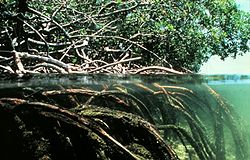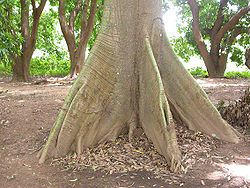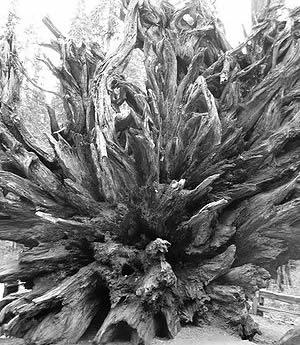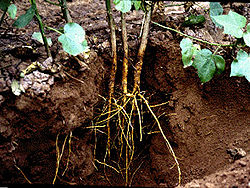Root
In vascular plants, the root is the organ of a plant body that typically lies below the surface of the soil. This is not always the case, however, since a root can also be aerial (that is, growing above the ground) or aerating (that is, growing up above the ground or especially above water). Furthermore, a stem normally occurring below ground is not exceptional either (see rhizome). So, it is better to define root as a part of a plant body that bears no leaves, and therefore also lacks nodes. There are also important internal structural differences between stems and roots. The two major functions of roots are 1) absorption of water and inorganic nutrients and 2) anchoring of the plant body to the ground. In response to the concentration of nutrients, roots also synthesise cytokinin, which acts as a signal as to how fast the shoots can grow. Roots often function in storage of food and nutrients. The roots of most vascular plant species enter into symbiosis with certain fungi to form mycorrhizas, and a large range of other organisms including bacteria also closely associate with roots.Contents
» Root growth» Types of roots
» Specialized roots
» Rooting depths
» Deepest Records for Rooting Depth
» Root architecture
» Evolutionary history
» Economic importance
» Notes
» References
Root growth

Cross Section of a mango tree

Root systems of prairie plants

Root system of a prairie grass

Stilt roots in the Amazon Rainforest support a tree in very soft, wet soil conditions

Aerating roots of a mangrove

Buttress roots of Ceiba pentandra

Roots from a fallen redwood at Yosemite National Park
Roots will generally grow in any direction where the correct environment of air, mineral nutrients and water exists to meet the plant's needs. Roots will not grow in dry soil. Over time, given the right conditions, roots can crack foundations, snap water lines, and lift sidewalks. At germination, roots grow downward due to gravitropism, the growth mechanism of plants that also causes the shoot to grow upward. In some plants (such as ivy), the "root" actually clings to walls and structures.
Growth from apical meristems is known as primary growth, which encompasses all elongation. Secondary growth encompasses all growth in diameter, a major component of woody plant tissues and many nonwoody plants. For example, storage roots of sweet potato have secondary growth but are not woody. Secondary growth occurs at the lateral meristems, namely the vascular cambium and cork cambium. The former forms secondary xylem and secondary phloem, while the latter forms the periderm.
In plants with secondary growth, the vascular cambium, originating between the xylem and the phloem, forms a cylinder of tissue along the stem and root. The cambium layer forms new cells on both the inside and outside of the cambium cylinder, with those on the inside forming secondary xylem cells, and those on the outside forming secondary phloem cells. As secondary xylem accumulates, the "girth" (lateral dimensions) of the stem and root increases. As a result, tissues beyond the secondary phloem (including the epidermis and cortex, in many cases) tend to be pushed outward and are eventually "sloughed off" (shed).
At this point, the cork cambium begins to form the periderm, consisting of protective cork cells containing suberin. In roots, the cork cambium originates in the pericycle, a component of the vascular cylinder.
The vascular cambium produces new layers of secondary xylem annually. The xylem vessels are dead at maturity but are responsible for most water transport through the vascular tissue in stems and roots.
Types of roots
A true root system consists of a primary root and secondary roots (or lateral roots).The primary root originates in the radicle of the seedling. It is the first part of the root to be originated. During its growth it rebranches to form the lateral roots. It usually grows downwards. Generally, two categories are recognized:
» the taproot system: the primary root is prominent and has a single, dominant axis; there are fibrous secondary roots running outward. Usually allows for deeper roots capable of reaching low water tables. Most common in dicots. The main function of the taproot is to store food.
» the diffuse root system: the primary root is not dominant; the whole root system is fibrous and branches in all directions. Most common in monocots. The main function of the fibrous root is to anchor the plant.
Specialized roots
The roots, or parts of roots, of many plant species have become specialized to serve adaptive purposes besides the two primary functions described in the introduction. » Adventitious roots arise out-of-sequence from the more usual root formation of branches of a primary root, and instead originate from the stem, branches, leaves, or old woody roots. They commonly occur in monocots and pteridophytes, but also in many dicots, such as clover (Trifolium), ivy (Hedera), strawberry (Fragaria) and willow (Salix). Most aerial roots and stilt roots are adventitious. In some conifers adventitious roots can form the largest part of the root system.» Aerating roots (or pneumatophores): roots rising above the ground, especially above water such as in some mangrove genera (Avicennia, Sonneratia). In some plants like Avicennia the erect roots have a large number of breathing pores for exchange of gases.
» Aerial roots: roots entirely above the ground, such as in ivy (Hedera) or in epiphytic orchids. They function as prop roots, as in maize or anchor roots or as the trunk in strangler fig.
» Contractile roots: they pull bulbs or corms of monocots, such as hyacinth and lily, and some taproots, such as dandelion, deeper in the soil through expanding radially and contracting longitudinally. They have a wrinkled surface.
» Coarse roots: Roots that have undergone secondary thickening and have a woody structure. These roots have some ability to absorb water and nutrients, but their main function is transport and to provide a structure to connect the smaller diameter, fine roots to the rest of the plant.
» Fine roots: Primary roots usually <2 mm diameter that have the function of water and nutrient uptake. They are often heavily branched and support mycorrhizas. These roots may be short lived, but are replaced by the plant in an ongoing process of root 'turnover'.
» Haustorial roots: roots of parasitic plants that can absorb water and nutrients from another plant, such as in mistletoe (Viscum album) and dodder.
» Propagative roots: roots that form adventitious buds that develop into aboveground shoots, termed suckers, which form new plants, as in Canada thistle, cherry and many others.
» Proteoid roots or cluster roots: dense clusters of rootlets of limited growth that develop under low phosphate or low iron conditions in Proteaceae and some plants from the following families Betulaceae, Casuarinaceae, Eleagnaceae, Moraceae, Fabaceae and Myricaceae.
» Stilt roots: these are adventitious support roots, common among mangroves. They grow down from lateral branches, branching in the soil.
» Storage roots: these roots are modified for storage of food or water, such as carrots and beets. They include some taproots and tuberous roots.
» Structural roots: large roots that have undergone considerable secondary thickening and provide mechanical support to woody plants and trees.
» Surface roots: These proliferate close below the soil surface, exploiting water and easily available nutrients. Where conditions are close to optimum in the surface layers of soil, the growth of surface roots is encouraged and they commonly become the dominant roots.
» Tuberous roots: A portion of a root swells for food or water storage, e.g. sweet potato. A type of storage root distinct from taproot.
"Pneumatophores" Water even after air has been bubbled through it contains less than one-thirteenth the oxygen as air. some swamp plants such as black mangrove devolop spongy roots called pneumatophores which go above waters surface and enhance gas exchange.
Rooting depths
The distribution of vascular plant roots within soil depends on plant form, the spatial and temporal availability of water and nutrients, and the physical properties of the soil. The deepest roots are generally found in deserts and temperate coniferous forests; the shallowest in tundra, boreal forest and temperate grasslands. The deepest observed living root, at least 60 m below the ground surface, was observed during the excavation of an open-pit mine in Arizona, USA. Some roots can grow as deep as the tree is high. The majority of roots on most plants are however found relatively close to the surface where nutrient availability and aeration are more favourable for growth. Rooting depth may be physically restricted by rock or compacted soil close below the surface, or by anaerobic soil conditions.Deepest Records for Rooting Depth
| Species | System | Maximum rooting depth (m) |
Reference |
| Boscia albitrunca | Kalahari desert | 68 | Jennings (1974) |
| Juniperus monosperma | Colorado Plateau | 61 | Cannon (1960) |
| Eucalyptus sp. | Australian forest | 61 | Jennings (1971) |
| Acacia erioloba | Kalahari desert | 60 | Jennings (1974) |
| Prosopis juliflora | Arizona desert | 54 | Phillips (1963) |
Root architecture
The pattern of development of a root system is termed 'root architecture', and is important in providing a plant with a secure supply of nutrients and water as well as anchorage and support. The architecture of a root system can be considered in a similar way to above-ground architecture of a plant - i.e. in terms of the size, branching and distribution of the component parts. In roots, the architecture of fine roots and coarse roots can both be described by variation in topology and distribution of biomass within and between roots. Having a balanced architecture allows fine roots to exploit soil efficiently around a plant, but the 'plastic' nature of root growth allows the plant to then concentrate its resources where nutrients and water are more easily available. A balanced coarse root architecture, with roots distributed relatively evenly around the stem base, is necessary to provide support to larger plants and trees.Evolutionary history
The fossil record of roots - or rather, infilled voids where roots rotted after death - spans back to the late Silurian, but their identification is difficult, because casts and molds of roots are so similar in appearance to animal burrows - although they can be discriminated on the basis of a range of features.
Roots can also protect the environment by holding the soil to prevent soil erosion

Tree roots at Cliffs of the Neuse State Park, NC
Economic importance
The term root crops refers to any edible underground plant structure, but many root crops are actually stems, such as potato tubers. Edible roots include cassava, sweet potato, beet, carrot, rutabaga, turnip, parsnip, radish, yam and horseradish. Spices obtained from roots include sassafras, angelica, sarsaparilla and licorice.Sugar beet is an important source of sugar. Yam roots are a source of estrogen compounds used in birth control pills. The fish poison and insecticide rotenone is obtained from roots of Lonchocarpus spp. Important medicines from roots are ginseng, aconite, ipecac, gentian and reserpine. Several legumes that have nitrogen-fixing root nodules are used as green manure crops, which provide nitrogen fertilizer for other crops when plowed under. Specialized bald cypress roots, termed knees, are sold as souvenirs, lamp bases and carved into folk art. Native Americans used the flexible roots of white spruce for basketry.
Tree roots can heave and destroy concrete sidewalks and crush or clog buried pipes. The aerial roots of strangler fig have damaged ancient Mayan temples in Central America and the temple of Angkor Wat in Cambodia.
Vegetative propagation of plants via cuttings depends on adventitious root formation. Hundreds of millions of plants are propagated via cuttings annually including chrysanthemum, poinsettia, carnation, ornamental shrubs and many houseplants.
Roots can also protect the environment by holding the soil to prevent soil erosion.
Notes
- Retallack, G. J. (1986). Wright, V. P.. ed. Paleosols: their Recognition and Interpretation. Oxford: Blackwell.- Hillier, R, Edwards, D;Other, A.N. (2008). "Sedimentological evidence for rooting structures in the Early Devonian Anglo–Welsh Basin (UK), with speculation on their producers". Palaeogeography Palaeoclimatology Palaeoecology.
References
- Brundrett, M. C. 2002. Coevolution of roots and mycorrhizas of land plants. New phytologist 154(2): 275-304.- Chen, R., E. Rosen, P. H. Masson. 1999. Gravitropism in Higher Plants. Plant Physiology 120 (2): 343-350.
- Coutts, M.P. 1987. Developmental processes in tree root systems. Canadian Journal of Forest Research 17: 761-767.
- Raven, J. A., D. Edwards. 2001. Roots: evolutionary origins and biogeochemical significance. Journal of Experimental Botany 52 (Suppl 1): 381-401.
- Schenk, H.J., and R.B. Jackson. 2002. The global biogeography of roots. Ecological Monographs 72 (3): 311-328.
- Sutton, R.F., and R.W. Tinus. 1983. Root and root system terminology. Forest Science Monograph 24 pp 137.
- Phillips, W.S. 1963. Depth of roots in soil. Ecology 44 (2): 424.





